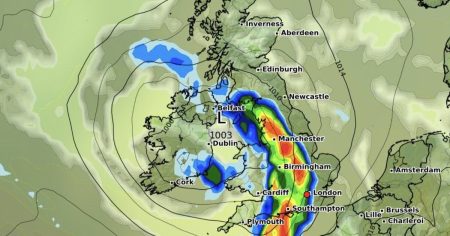The UK is bracing for the impact of anticipated strong winds, prompting the issuance of yellow weather warnings across various regions. These warnings signify a heightened risk of disruption and potential damage, including structural harm to buildings, widespread power outages, and significant travel disruptions. Meteorological forecasts predict gusts reaching potentially damaging speeds, capable of dislodging roof tiles, felling trees, and causing other structural vulnerabilities. Authorities are strongly advising residents to take proactive measures to safeguard their properties and prepare for possible power cuts and travel delays. This includes securing loose objects in gardens and balconies, reinforcing vulnerable structures, and ensuring they have essential supplies in case of extended power outages.
The anticipated strong winds pose a multifaceted threat to infrastructure and daily life. Power lines are particularly susceptible to damage, potentially leading to widespread blackouts affecting homes, businesses, and essential services. Fallen trees and debris on roads and railway lines are expected to cause significant travel disruptions, including flight cancellations, train delays, and hazardous driving conditions. Coastal areas are likely to experience large waves and coastal flooding, placing coastal communities and infrastructure at risk. Emergency services are preparing for a surge in calls related to wind-related incidents, urging the public to exercise caution and avoid unnecessary travel during the peak of the storm.
The advice to protect properties emphasizes the potential for wind-related damage to homes and businesses. Loose objects, such as garden furniture, trampolines, and hanging baskets, can become airborne projectiles in high winds, posing a danger to people and property. Securing these items is crucial to minimizing the risk of damage. Checking for loose roof tiles and securing any vulnerable structures, such as sheds or greenhouses, can also help prevent more substantial damage. Preparing for power outages involves ensuring access to alternative light sources, such as flashlights and candles, charging electronic devices, and stocking up on non-perishable food and water. Having a battery-operated radio can also be essential for staying informed about weather updates and emergency instructions.
The potential for travel chaos underscores the importance of careful planning and consideration for anyone intending to travel during the period of high winds. Checking for travel updates and potential delays before embarking on any journeys is crucial. Airlines are likely to announce flight cancellations or delays, and train services may be disrupted or suspended. Driving conditions are expected to be challenging, with strong winds posing a risk of loss of control, especially for high-sided vehicles. If travel is absolutely necessary, drivers are advised to reduce speed, maintain a safe distance from other vehicles, and be prepared for sudden gusts and debris on the roads.
Beyond the immediate impact on infrastructure and travel, the strong winds can also pose a risk to personal safety. The danger of falling trees and debris underscores the importance of staying indoors during the peak of the storm whenever possible. Avoiding coastal areas during periods of high winds and large waves is also essential to mitigate the risk of being swept away or injured by debris. Paying attention to weather warnings and adhering to safety advice from authorities are paramount to ensuring personal safety during severe weather events. Staying informed about changing weather conditions and potential hazards allows individuals to make informed decisions and take appropriate precautions.
In summary, the yellow weather warnings for strong winds signal a significant risk of disruption and potential damage across affected regions. The potential consequences range from structural damage to buildings and power outages to widespread travel disruptions and personal safety risks. Authorities are urging residents to take proactive measures to protect their properties, prepare for power cuts and travel delays, and prioritize personal safety during the anticipated period of strong winds. Staying informed about weather updates, adhering to safety advice, and exercising caution are crucial for minimizing the potential impact of this severe weather event. Planning ahead and taking appropriate precautions can help individuals and communities navigate the challenges posed by the strong winds and ensure their safety and well-being.














